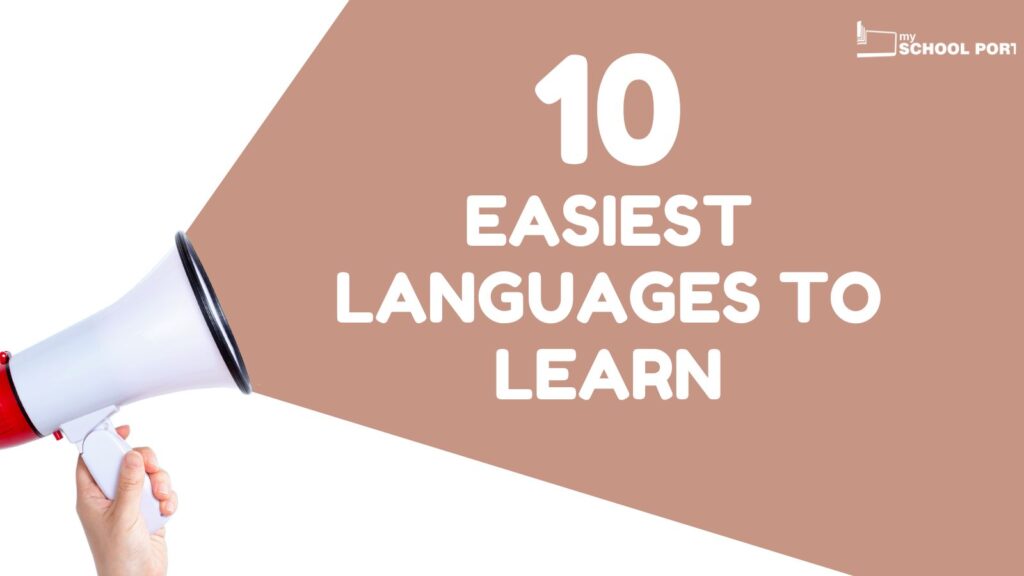Whether you’re planning to study abroad, volunteer, or take a gap year, spending time in a foreign country offers a fantastic chance to broaden your horizons—and learning a new language can be one of the most rewarding aspects of the experience. While mastering a new language takes dedication, consistency, and practice, some languages are notably easier for English speakers to learn.
If you’re looking to enhance your communication skills and create a deeper connection with the culture during your travels, we’ve curated a list of languages worth exploring. These languages not only open doors to new opportunities but also make your overseas experience more enriching and immersive.
1. Afrikaans
🌍 Native to: South Africa
🕒 Approximate time to learn: 24 weeks (600 hours)
🗣️ Number of speakers: 6 million
📍 Best destination to visit: South Africa
Afrikaans, a native language of South Africa, belongs to the West Germanic language family and shares similarities with Dutch, German, and other related languages. Although primarily derived from Dutch, it has also been influenced by Portuguese, Malay, and French, creating a unique linguistic blend. With approximately 6 million speakers, Afrikaans has also left its mark on South African English, with many words being borrowed into everyday use.
✅ Pros:
- Around 90% of Afrikaans vocabulary originates from Dutch, which is another Germanic language like English. This makes Afrikaans relatively easy for English speakers to pick up, especially in terms of vocabulary and pronunciation.
Example: “Color” is kleur, and “door” is deur—simple and recognizable!
🟨 Cons:
- Afrikaans has limited global reach compared to other languages, but its Dutch roots make it useful for travelers to the Netherlands or those learning Dutch.
- The trilled “r” can be challenging for English speakers to master, as it requires a unique tongue movement that isn’t commonly used in English pronunciation.
2. Dutch
🕒 Approximate time to learn: 24 weeks (575–600 hours)
🗣️ Number of speakers: 23 million native, 4 million second-language speakers
📍 Best countries to visit: Netherlands, Aruba, Northern Belgium
Dutch, a West Germanic language, is spoken by approximately 23 million people as their first language and an additional 4 million as a second language. It shares close ties with English, making it one of the easier languages for English speakers to learn. Dutch also influences related languages like Afrikaans, Flemish (spoken in Belgium), and Frisian. Its rich cultural and historical significance, especially in art, trade, and architecture, further adds to its charm as a language worth learning.
✅ Pros:
- Familiar Vocabulary: Many Dutch words are either identical to or closely resemble their English equivalents. For instance, “water” remains the same, while “boek” and “appel” translate to “book” and “apple.” This similarity makes learning vocabulary much easier.
- Simplified Grammar: Dutch grammar is relatively straightforward for English speakers, with only two past tense forms to master. It avoids the complexity of heavily inflected languages, making it more accessible.
🟨 Cons:
- Tricky Pronunciation: While Dutch words often look similar to English, their pronunciation can be misleading. Some words might require emphasizing sounds or letters differently from what English speakers are accustomed to. For example, the infamous Dutch “g” sound is guttural, which can take time to perfect.
By learning Dutch, you open yourself to a world of possibilities, from navigating the charming streets of Amsterdam to exploring the cultural hubs of Belgium and Aruba. It’s a practical and rewarding language for travel, business, and personal growth.
3. Norwegian
🕒 Approximate time to learn: 23–24 weeks (575–600 hours)
🗣️ Number of speakers: 4.4 million
📍 Best countries to visit: Norway, Sweden, Denmark
At first, learning Norwegian might seem intimidating, but it’s surprisingly one of the easiest languages for English speakers to pick up! Thanks to its Germanic roots and similarities in vocabulary and structure, Norwegian feels familiar to English learners. While it doesn’t have the global reach of some languages, it provides a gateway to the Scandinavian region, enhancing communication and travel across Norway, Sweden, and Denmark.
✅ Pros:
- Familiar Vocabulary: Norwegian shares many words with English or has similar-sounding counterparts. For example, “oransje” means orange, “fantastisk” means fantastic, and “ankel” translates to ankle. These shared roots make vocabulary acquisition a breeze.
- Simple Pronunciation: Most Norwegian words are pronounced as they’re spelled, making it easier to master the basics compared to languages with silent letters or complex intonations.
🟨 Cons:
- Special Characters: Norwegian uses additional letters like “å,” “ø,” and “æ,” which can take some practice to pronounce and recognize.
- Gendered Nouns: Like many European languages, Norwegian has gendered nouns, which may be a slight hurdle for English speakers who aren’t used to assigning genders to objects.
Learning Norwegian not only allows you to navigate Norway with ease but also gives you an understanding of Swedish and Danish, as these languages share a high degree of mutual intelligibility. Whether you’re exploring the stunning fjords or immersing yourself in Scandinavian culture, Norwegian is a practical and rewarding language to learn.
4. Spanish
🕒 Approximate time to learn: 24 weeks (600 hours)
🗣️ Number of speakers: 595 million (native and second-language speakers)
📍 Best countries to visit: Mexico, Colombia, Argentina, Chile, Costa Rica
Spanish is a globally dominant Romance language and the second-most spoken language worldwide. With over half a billion speakers, it holds cultural, economic, and social significance, making it an invaluable language to learn. While regional dialects vary across Spanish-speaking countries, its practicality and prominence in global media make it a popular choice for English speakers eager to expand their communication skills.
✅ Pros:
- Familiar Vocabulary: Spanish and English share many Latin-derived words, making it easier to learn and recognize terms. For instance, “attention” is atención, and “camera” is cámara—a pattern you’ll see repeated throughout the language.
- Phonetic Simplicity: Spanish is a phonetic language, meaning words are pronounced as they are written. Once you grasp the basics of pronunciation and accents, you’ll find reading and speaking straightforward.
🟨 Cons:
- Complex Grammar: Spanish grammar can be tricky for English speakers due to the numerous verb tenses, conjugations, and gendered nouns. Beginners often find themselves tempted to directly translate English grammar rules into Spanish, which can lead to mistakes.
Learning Spanish opens the door to 20 countries where it’s an official language, making it an excellent choice for travel, business, or simply enjoying popular Spanish-language movies, music, and literature. With persistence, it’s a highly rewarding language to master.
5. Italian
🕒 Approximate time to learn: 23–24 weeks (575–600 hours)
🗣️ Number of speakers: 63 million native speakers, 3 million second-language speakers
📍 Best countries to visit: Italy, Switzerland, parts of Croatia and Slovenia
Italian is one of the most beloved Romance languages, alongside Spanish and French. While it may not be as widely spoken globally, it’s the 20th most-spoken language, boasting 63 million native speakers and an additional 3 million second-language speakers. Italian’s influence extends far beyond its geographic borders, thanks to its prominence in global food culture, fashion, and cinema. Even if you’re new to the language, terms like “panini,” “gelato,” and “la dolce vita” might already sound familiar!
✅ Pros:
- Latin-Based Similarities: With Latin roots, Italian shares many linguistic patterns with English, making it easier to deduce the meanings of words. For example, “generosità” translates to generosity.
- Straightforward Pronunciation: Italian words are pronounced exactly as they are spelled, eliminating the guesswork involved in learning pronunciation.
🟨 Cons:
- Complex Verb Conjugations: Italian verbs follow intricate conjugation rules, with some endings changing entirely based on tense and subject. Beginners might find this aspect challenging.
- Unique Plural Forms: Unlike English, where plurals are typically formed by adding an “s,” Italian plurals often involve changing word endings completely (e.g., “libro” becomes “libri”).
Learning Italian not only allows you to connect with its rich culture but also enriches your travel experience across Italy and other parts of Europe. From ordering authentic pasta in Rome to admiring Renaissance art in Florence, speaking Italian ensures you savor every moment of la dolce vita!
6. Portuguese
🕒 Approximate time to learn: 23–24 weeks (575–600 hours)
🗣️ Number of speakers: 260 million
📍 Best countries to visit: Brazil, Portugal, Cape Verde, Macau, Mozambique
Portuguese, the official language of Brazil and Portugal, extends far beyond Europe and South America, with a strong presence in Africa and parts of Asia. As the third most spoken Romance language globally, Portuguese has over 260 million speakers. Learning Portuguese not only gives you access to a diverse set of countries but also lays a strong foundation for picking up other Romance languages like Spanish, Italian, or French.
✅ Pros:
- Shared Alphabet with English: Portuguese uses the same alphabet as English, making reading and writing more intuitive for English speakers.
- Familiar Intonation: Portuguese shares similar rhythmic patterns and intonation with English, making it easier to adapt to its sound system.
🟨 Cons:
- Regional Variations: European Portuguese and Brazilian Portuguese differ in vocabulary, pronunciation, and even grammar. If you’re planning an extended stay, focusing on the specific regional nuances is essential.
- False Cognates with Spanish: Many Portuguese words resemble Spanish but differ in pronunciation or meaning. For example, “biscoito” means “cookie” in Portuguese, while “bizcocho” in Spanish refers to “cake.” These subtle distinctions can be confusing for beginners.
Learning Portuguese not only enhances your travel experiences in Portugal and Brazil but also connects you with a vast, vibrant Lusophone world. From exploring the beaches of Rio de Janeiro to wandering Lisbon’s historic streets, Portuguese opens doors to unforgettable cultural and linguistic experiences.
7. French
🕒 Approximate time to learn: 24 weeks (575–600 hours)
🗣️ Number of speakers: 320 million (native and second-language speakers)
📍 Best countries to visit: France, Belgium, Switzerland, Ivory Coast, Morocco, Canada
French is the official language of 29 countries spanning Europe, Africa, the Americas, and the Caribbean, making it one of the most widely spoken and influential languages worldwide. With 320 million total speakers, French ranks as the 5th most spoken language globally. Its global reach and official use by major international organizations such as the United Nations, UNESCO, and the International Red Cross make French a valuable asset, especially for careers in diplomacy, international relations, or humanitarian efforts.
✅ Pros:
- Familiar Vocabulary: As a Latin-based language, French shares many similarities with English. Words like “attention” (attention) and “nation” (nation) are practically identical, easing the learning process.
- Cultural Familiarity: French has had a significant influence on global culture, especially in gastronomy and art. Phrases like “à la carte” and “c’est la vie” are already part of everyday English, giving you a head start.
🟨 Cons:
- Challenging Pronunciation: French pronunciation rules can be tricky, as many words are not pronounced the way they appear. Silent letters, nasal sounds, and liaison rules require practice to master.
Learning French not only opens doors to exploring vibrant destinations like Paris and Montreal but also connects you to diverse cultures in Africa, the Caribbean, and beyond. As the language of diplomacy and elegance, mastering French offers both personal and professional rewards.
8. Romanian
🕒 Approximate time to learn: 24 weeks (575–600 hours)
🗣️ Number of speakers: 28 million (15 million native speakers)
📍 Best countries to visit: Romania, Moldova
Romanian is often overlooked as a Romance language, but it shares significant similarities with French, Italian, and Spanish. Despite being part of the same language family, Romanian has the smallest global reach compared to its counterparts, with 28 million total speakers. For travelers seeking a unique linguistic and cultural experience, learning Romanian offers insight into the rich traditions and history of Eastern Europe, particularly in Romania and Moldova.
✅ Pros:
- Phonetic Language: Romanian words are pronounced exactly as they are spelled, much like Spanish, making pronunciation easier for learners.
- Latin-Based Vocabulary: Romanian’s Latin roots allow learners to intuitively recognize many words, especially if they are familiar with other Romance languages.
🟨 Cons:
- Grammatical Complexity: Romanian features noun declensions that change based on the verb or context in a sentence. This grammatical structure is closer to Slavic languages like Russian or Polish, which may feel unfamiliar to learners of other Romance languages.
- Influence of Neighboring Languages: Due to its geographic location, Romanian has absorbed some Slavic vocabulary from nearby countries, which can make certain words and dialects challenging to grasp.
Learning Romanian provides an opportunity to connect with a lesser-known but fascinating Romance language. Whether you’re exploring the historic castles of Transylvania or the vibrant streets of Bucharest, speaking Romanian allows you to engage more deeply with the local culture and people.
9. Swahili
🕒 Approximate time to learn: 36 weeks (900 hours)
🗣️ Number of speakers: 80 million
📍 Best countries to visit: Tanzania, Kenya, Uganda, Mozambique
Swahili, the official language of Kenya, Tanzania, and several other East African countries, boasts over 80 million speakers. Swahili’s wide usage across East Africa and its unique blend of influences from Arabic, German, French, and English make it an intriguing language to learn. With its straightforward pronunciation and growing global significance, learning Swahili can open doors to exploring some of Africa’s most iconic destinations and cultures.
✅ Pros:
- Easy Pronunciation: Swahili is phonetic, meaning words are pronounced exactly as they are written, without silent letters or complex accents.
- Familiar Vocabulary: Many Swahili words resemble their English counterparts, such as “hoteli” (hotel) and “safari” (journey), making it easier for English speakers to grasp.
- Pop Culture Familiarity: Thanks to the iconic movie The Lion King, you may already be familiar with words like “Simba” (lion), “Rafiki” (friend), “Pumbaa” (silly person), and the popular phrase “Hakuna Matata” (no worries).
🟨 Cons:
- Sentence Structure: Swahili sentence structure, including the use of participles and prefixes, can be challenging for beginners. The placement of words in a sentence is different from English, which may require some adjustment.
Swahili offers not just a linguistic adventure but a deeper connection to the diverse cultures of East Africa. Whether you’re exploring the Serengeti or interacting with locals in Nairobi, learning Swahili enhances your travel and cultural experience.
10. Tagalog
🕒 Approximate time to learn: 44 weeks (1100 hours)
🗣️ Number of speakers: 45 million
📍 Best countries to visit: Philippines
Tagalog, one of the official languages of the Philippines, is part of the Austronesian language family, sharing roots with languages like Malay and Sundanese. With around 45 million speakers, Tagalog is widely spoken throughout the Philippines. While Tagalog is the formal language, a commonly used variation, “Taglish,” blends Tagalog with English and is prevalent in everyday conversation.
✅ Pros:
- Straightforward Pronunciation: Tagalog is relatively easy to pronounce, with no complex sounds or tones to master. Many words also share similarities with English, Spanish, and Malay, making them easier to recognize.
- English Loanwords: Tagalog has borrowed numerous words from English, often with only slight spelling changes. For example, “doctor” becomes doktor, and “computer” becomes kompyuter, making them familiar to English speakers.
🟨 Cons:
- Sentence Structure and Verb Conjugation: The most challenging aspect of learning Tagalog for English speakers is its sentence structure and verb conjugation. Unlike English, Tagalog uses a focus system for verbs, where the subject of a sentence is indicated by the verb, requiring learners to adjust to a different word order. Additionally, some words don’t have direct English equivalents, which can be tricky for translation.
Despite the challenges, learning Tagalog opens doors to connecting with over 45 million people and exploring the rich culture and landscapes of the Philippines. Whether you’re strolling along the white sand beaches of Boracay or engaging with locals in Manila, speaking Tagalog can enhance your travel experience.
Related
Stay updated with the latest student resources and insights from My School Portal! Subscribe to our newsletter for fresh content delivered straight to your inbox—no spam, just value 😊












